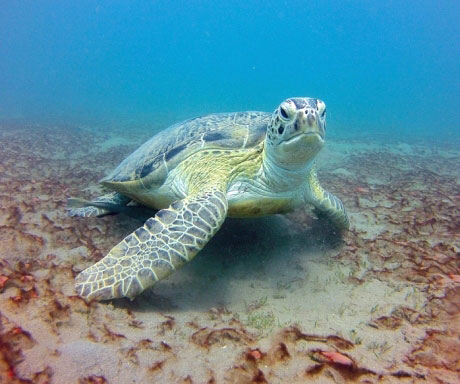Green Turtle, Chelonia mydas
30 September 2019
On the IUCN Red List of endangered species, the numbers of these beautiful, graceful animals are still decreasing. The IUCN writes that "Perhaps the most detrimental human threats to green turtles are the intentional harvests of eggs and adults from nesting beaches and juveniles and adults from foraging grounds."1 Other threats include fishing bycatch, loss of habitat, light pollution, disease and unbalanced sex ratios caused by warmer temperatures in nesting areas.

Photo credit David Collins, taken in Marsa Alam, Red Sea.
The book Fire in the Turtle House tells how turtles have been hunted to populations that are a shadow of their former glory and how they now face widespread fibropapillomatosis (or FP), a debilitating plague of tumours that threatens to consign them to the history books.
In addition over 37000 green turtles are legally killed each year, mostly by Nicaragua, Papua New Guinea and Australia. [Tweet This!]
The sex of turtle hatchlings is determined by the temperature at which the eggs develop in the nest. Higher temperatures favour the production of females. Turtles have evolved to synchronize their nesting with times of year when the incubation temperature produces roughly equal numbers of male and females. In areas where turtles are already nesting at the coolest time of the year, any increase in temperature means fewer and fewer males.

Photo credit Javier Grinfeld, taken at Abu Dabbab, Red Sea.
A female turtle breeds only every three to four years, although she lays several clutches of eggs in a nesting season. However male reproductive intervals may be shorter than the female's, and males may visit multiple rookeries. Which could offset the male - female imbalance.
Some interesting methods are being tried to reduce green turtle bycatch. For instance, attaching ultraviolet light-emitting diodes to nets reduces the number of turtles inadvertantly caught by 40%2.
Green turtles appear to be the longest-lived of any sea turtle. Some estimates put it at up to 50 years3. But estimates vary considerably.
They are also one of the largest turtles, growing to 120 cm and weighing 230 kg. Young green turtles eat a variety of things but as they age they switch exclusively to seagrass and seaweed.
Chelonia mydas can migrate more than 2600 km between their feeding and nesting grounds. Male turtles do not leave the sea except to bask in the sun. You find them in all tropical and sub-tropical seas.
Further Reading
142,000 Turtles Legally Killed each Year
Fire in the Turtle House by Osha Gray Davidson
IUCN Red List
2Wang et al, Developing ultraviolet illumination of gillnets as a method to reduce sea turtle bycatch. Biol. Lett. 23 October 2013 vol. 9 no. 5 20130383.
3The Biology of Sea Turtles Volume III, edited by Jeanette Wyneken, Kenneth J. Lohmann, John A. Musick



